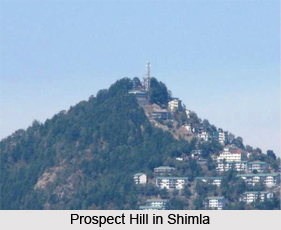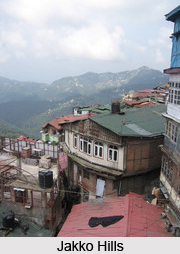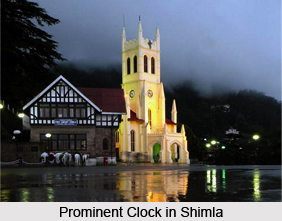 Shimla was once the summer capital of the British India. Presently this city in Himachal Pradesh is a major hill station. It is perched on a transverse spur of the central Himalayan system at a height of 7,084 feet above sea level. This region primarily developed under the reign of the British. English attention was drawn first to the area during the Nepal War of 1815, and in 1822 Captain Charles Kennedy was appointed Superintendent of the Hill States. It was he who erected the first house in 1825. Owing to the pleasant climate, the station rapidly acquired a reputation as a sanatorium. In 1827 the Governor-General Lord Amherst visited the town and five years later his successor, Lord William Bentinck, spent the summer here, establishing the tradition of Shimla as the hot-weather headquarters of the government of India, one which continued until 1947. The town is a curiously ramshackle affair built largely of timber, corrugated and cast iron. It has been called the Indian Capua, Mount Olympus and the `Abode of the Little Tin Gods.`
Shimla was once the summer capital of the British India. Presently this city in Himachal Pradesh is a major hill station. It is perched on a transverse spur of the central Himalayan system at a height of 7,084 feet above sea level. This region primarily developed under the reign of the British. English attention was drawn first to the area during the Nepal War of 1815, and in 1822 Captain Charles Kennedy was appointed Superintendent of the Hill States. It was he who erected the first house in 1825. Owing to the pleasant climate, the station rapidly acquired a reputation as a sanatorium. In 1827 the Governor-General Lord Amherst visited the town and five years later his successor, Lord William Bentinck, spent the summer here, establishing the tradition of Shimla as the hot-weather headquarters of the government of India, one which continued until 1947. The town is a curiously ramshackle affair built largely of timber, corrugated and cast iron. It has been called the Indian Capua, Mount Olympus and the `Abode of the Little Tin Gods.`
Shimla is built across a range of hills and connecting ridges. This imparts a distinct identity to the different quarters. The principal hills are Jakko, Prospect Hill, Observatory Hill, Elysium Hill and Summer Hill. But most of the houses and major buildings are concentrated on and around the Ridge, the outstanding feature of the town, which runs east to west in a crescent from Jakko Hill and Chota Shimla to Prospect Hill and Boileauganj. Spectacular views can be obtained to the north: rows of snow-capped mountain peaks disappearing in the distance. To the south are the Kasauli Hills and the valley of the Sutlej.
The town is dominated by the silhouette of Christ Church, which can be seen on the skyline for miles around. Designed by Colonel J. T. Boileau, it was commenced in September 1844, consecrated in January 1857 and subsequently extended. The porch was added in 1873. The clock was donated by Colonel Dumbleton in 1860. The five stained-glass windows depict Faith, Hope, Charity, Fortitude, and Patience and Humility. No trace now remains of the frescoes around the chancel window designed by John Lockwood Kipling. The church was never large enough for the seasonal influx of Europeans. In 1860 the vicar berated the ladies in the congregation because their crinolines occupied so much space at the expense of other worshippers. Note the interesting brasses and plaques.
 Another building that mirrors the colonial influence is the Library that was built in the year 1910. It was designed by James Ransome with half-timbered gables. The original external staircase has been removed. Around the open space on the ridge are the bandstand and Mahatma Gandhi`s statue. To the north, the highest peak in the vicinity is Shali, 9,400 feet, with Elysium Hill in the foreground. Between the Library and Church is the most direct path to Jakko hills, where there is the well-known Monkey Temple.
Another building that mirrors the colonial influence is the Library that was built in the year 1910. It was designed by James Ransome with half-timbered gables. The original external staircase has been removed. Around the open space on the ridge are the bandstand and Mahatma Gandhi`s statue. To the north, the highest peak in the vicinity is Shali, 9,400 feet, with Elysium Hill in the foreground. Between the Library and Church is the most direct path to Jakko hills, where there is the well-known Monkey Temple.
The main road descends to Chota Shimla passing the Barnes Court. It is a large rambling building with half-timbered gables and was once the residence of the Lieutenant-Governor. Lord Napier of Magdala, Sir Colin Campbell and Sir Hugh Rose resided here once upon a time. John Lockwood Kipling added a Moorish-style ballroom. Today it serves as the offices of the State secretariat. The General Post Office, built in 1886 AD, has been carved out of a fine range of timber. It is built in the style, known as, Wild West Swiss.
The main road of Shimla that runs westwards is dominated by the spires and turrets of Gorton Castle, a gaunt, romantic pile designed by Sir Samuel Swinton Jacob for the Civil Secretariat but considerably modified during its construction by Major H. F. Chesney. By the entrance of Gorton Castle a road to the left leads to the Railway Station. Another to the right goes to Annandale.
The Viceregal Lodge is used as an Institute of Advanced Study. It was built for the Viceroy Lord Duffenn, who himself suggested the plan and interfered at every stage. Designed by Henry Irwin and Captain H. H. Cole, with F, B. Hebbert and Hon. L. M. St Clair as executive engineers, it was completed in 1888 in a gaunt Elizabethan style in light-blue limestone dressed with light-grey sandstone. The site was entirely appropriate for the Lords of the Indian Empire as the hill is a natural watershed, with water flowing down to the Sutlej River and on to the Arabian Sea on one side and on the other into the Yamuna and out into the Bay of Bengal.
The Viceregal Lodge resembles an English country house or Scottish sanatorium, but the garden enjoys spectacular views of the Himalayas. Externally, it is dominated by a high central tower containing the water tanks and an octagonal corner bay crowned by a cupola. Internally, there is a fine entrance hall and staircase and a huge central gallery executed in teak. At ground-floor level is the State Ballroom and State Dining-Room, the latter enriched with teak panelling which once carried the armorial bearings of the Indian Governor-Generals and Viceroys. Only the inscriptions now remain. The original furniture is by Maples. The mirrors over the chimney pieces come from King Thebaw`s palace at Mandalay. In a small room at first floor level the treaty leading to Indian Independence was signed by Lord Mountbatten, Jawaharlal Nehru and the Indian nationalists.
In the garden area is an inscribed bronze plate indicating the names of the distant peaks, a sundial and other memorabilia. The outbuildings, including the nursery and gate lodge, are also of interest. The little Chapel of All Saints (1885) lies within the compound as well.
From Viceregal Lodge, the upper road leads to Summer Hill, the lower to Boileauganj. From Summer Hill there is a precipitous path down to Chadwick Falls.
From Boileauganj the Mall leads back to the centre of Shimla. Besides these the monuments of Shimla also include the Roman Catholic Church of St Michael and St Joseph, a Gothic building completed in 1900 AD by the addition of a steeple and belfry. There is some good stained glass. Nearby are the District Courts and St Thomas`s School. This leads back to the Telegraph Office, with its prominent clock.
The principal mosque, the Sandagaron Ki Masjid, was built in 1910 AD. It is an undistinguished building in Middle Bazaar. On the other hand, St Crispin`s Church (1920) is here, just like an English village church, built to commemorate the fallen of the First World War, with fine stained-glass memorial windows. The Retreat nearby was once the residence of Sir William Henry, the Commissioner of the Hill States. Often it was rented to the Commander-in-Chief as a refuge.
The monuments of Shimla thus are a curios mix of religious and historical buildings. However, what remains common between these two types of monuments is their idiom; both have been built by following the colonial architectural style.



















